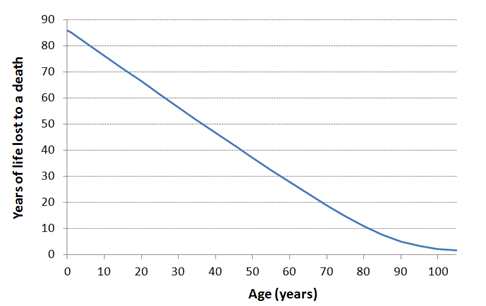Years of life lost
To translate deaths by age, sex and cause into years of life lost, requires a set of assumptions about how much life is lost by individuals who die at each age. This loss of life could be calculated in various ways. One obvious possibility is to use the individuals’ expectation of life at that age. However, this assumption implies that, at any age, the death of someone in a high mortality country contributes less to the global burden of disease than the death of someone in a low mortality country. This is inequitable.
Therefore, GBD studies calculate YLL with reference to the expectation of life at each age in a low mortality reference life table. In algebraic terms:
where Di,x represents deaths from cause i at age x and ex* represents the expectation of life at age x in the reference life table.
For the 1990 study, the reference life table for women had a life expectancy at birth of 82.5 years and was based on the experience of Japanese women at that time; the reference life table for men had a life expectancy at birth of 80 years.
Years of life lost by age, 2010 GBD study

For the 2010 study, a new standard life table was constructed based on the lowest death rate at each age observed in any population to date. It has a life expectancy at birth of 86.02 years. The difference between the expectation of life of men and women has been shrinking and it is unclear whether it has an irreducible biological component. Therefore, on the basis that society should at least aspire to reducing men’s mortality to the same level as women’s mortality, the same reference standard was used by the 2010 GBD study to calculate YLL for both sexes.